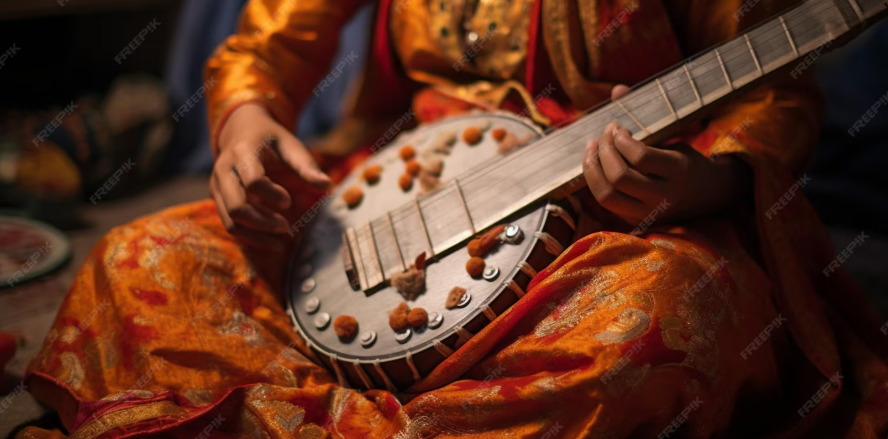Raag Adbhut Ranjani stands as one of the most captivating ragas in Indian classical music, blending wonder, devotion, and joy into a melody that transcends the ordinary. The word Adbhut means “extraordinary” or “wondrous,” while Ranjani means “that which delights.” Together, they form a raga that inspires awe and emotional elevation. Its music is said to touch the core of one’s being, evoking a sense of divine amazement and gentle bliss.
It belongs to the Carnatic tradition but finds resonance in Hindustani adaptations as well. The tonal movement of Adbhut Ranjani is mesmerizing — bright, fluid, and rich in emotion. Its flow invites both introspection and elation, making it one of the most spiritually engaging melodic forms in classical repertoire.
Key takeaway: Raag Adbhut Ranjani combines awe (Adbhut Rasa) and delight (Ranjani) to create a melody that uplifts the listener’s soul and fills the atmosphere with grace.
2. The Historical and Cultural Roots
The origins of Raag Adbhut Ranjani are somewhat obscure but are believed to have evolved from explorations of the Ranjani family of ragas in Carnatic music. The Ranjani family — which includes Sriranjani, Janaranjani, Shuddha Ranjani, and Manoranjani — is known for its capacity to evoke joy and beauty. Adbhut Ranjani, as the name suggests, brings a dimension of wonder and serenity to this lineage.
Musicians consider this raga a modern addition inspired by ancient tonal patterns, where the focus was not just on technical perfection but on evoking an ethereal emotion. It is often performed in concerts as a bridge between light classical and spiritual segments, drawing the audience into a state of meditative happiness.
Key takeaway: Adbhut Ranjani is a modern gem with ancient roots, symbolizing the evolution of joy into wonder through music.
Do you know?
Which emotion or ‘Rasa’ does Raag Adbhut Ranjani primarily express?
Answer: Raag Adbhut Ranjani primarily expresses Adbhut Rasa — the emotion of wonder and amazement. It is associated with feelings of reverence, discovery, and spiritual bliss, reflecting the beauty of the universe through melody.
3. The Emotional Meaning and Aesthetic Essence
The Raag Adbhut Ranjani meaning lies in its capacity to evoke emotional purity. It symbolizes a union of joy and curiosity — the feeling of witnessing something extraordinary in the ordinary. The mood of this raga is serene, introspective, and celebratory, evoking both devotion and delight.
Listeners often describe the Raag Adbhut Ranjani mood as “expansive yet intimate.” It opens the heart while calming the mind, allowing the listener to dwell in silence and sound simultaneously. This duality is what makes the raga so mesmerizing; it brings stillness within movement and movement within stillness.
Key takeaway: The mood of Adbhut Ranjani is tranquil yet joyful — it encourages the listener to embrace wonder with a peaceful heart.

4. Notes, Structure, and Scale of Adbhut Ranjani
The tinct for their symmetry and emotive pull. The raga typically follows a pentatonic (audava) scRaag Adbhut Ranjani notes (swaras) are disale, omitting certain notes to create an airy, open texture that allows emotional interpretation.
- Aaroh (Ascending): S R₂ G₃ P N₃ S
- Avroh (Descending): S N₃ P G₃ R₂ S
- Jati: Audava–Audava (five notes in both ascent and descent)
- Vadi (Main Note): Gandhar (G₃)
- Samvadi (Second Important Note): Nishad (N₃)
- Thaat: Kalyan
This limited scale gives immense scope for emotional improvisation. The exclusion of Ma and Dha leaves room for subtle ornamentation, which brings out the “Adbhut” character.
Key takeaway: Adbhut Ranjani’s five-note structure offers simplicity that allows deep emotional expression — proof that fewer notes can carry boundless feeling.
Do you know?
Which raga shares structural similarity with Adbhut Ranjani?
Answer: Raag Hamsadhwani shares structural similarities with Adbhut Ranjani as both are pentatonic ragas derived from the Kalyan Thaat. However, Adbhut Ranjani leans more toward meditative wonder, while Hamsadhwani radiates devotional enthusiasm.
5. The Ideal Time and Season for Adbhut Ranjani
The Raag Adbhut Ranjani time is traditionally associated with the evening, particularly just after sunset. This is the period when nature transitions from light to darkness — a time filled with reflective beauty. The raga’s gentle notes complement this ambience perfectly, calming the listener and preparing the mind for peace.
It can also be performed during early morning hours, especially in meditative settings, as its tranquil tonality mirrors the freshness of dawn. Many musicians prefer it for devotional gatherings or classical concerts that aim to uplift and relax the audience.
Key takeaway: Adbhut Ranjani resonates best during twilight or early morning, aligning with moments of transition and spiritual quiet.
6. Adbhut Ranjani in Performance and Expression
In live performances, Raag Adbhut Ranjani allows for both technical and emotional exploration. Its limited note set challenges the musician to rely on expression rather than ornamentation. Artists often start with a slow alap, gradually revealing the beauty hidden in each phrase.
In vocal music, Adbhut Ranjani compositions are known for their lyrical fluidity and purity. Instrumentalists on veena, flute, or sitar often favor it for its gentle tonal curve and meditative texture. The raga’s flow is continuous — it does not rush but glides, like a soft breeze over calm waters.
Key takeaway: Adbhut Ranjani shines when performed with restraint and sensitivity; its beauty lies in subtle expression rather than grandeur.
Do you know?
What makes Raag Adbhut Ranjani different from other Ranjani ragas?
Answer: While other Ranjani ragas like Sriranjani or Janaranjani express joy and devotion, Adbhut Ranjani adds a layer of mystery and spiritual wonder. Its tonal design invites inward reflection rather than outward celebration.

7. Lyrics and Compositions in Adbhut Ranjani
The Raag Adbhut Ranjani lyrics are often written in praise of divinity, nature, or the wonder of life itself. The language used in such compositions tends to be simple yet evocative, focusing on emotional connection rather than ornamentation. In Carnatic tradition, kriti and varnam compositions in this raga celebrate beauty through simplicity.
In Hindustani adaptations, khayals and bhajans in Adbhut Ranjani emphasize devotion with stillness. Modern composers also use it in semi-classical and fusion genres, combining Indian melodies with ambient or instrumental backdrops to highlight its meditative charm.
Key takeaway: The lyrics of Adbhut Ranjani explore the divine through simplicity — every line becomes a prayer set to melody.
8. The Mood and Therapeutic Value
The Raag Adbhut Ranjani mood is one of awe and harmony. It embodies balance — joy without excitement, peace without emptiness. Its gentle swaras create a calming vibration, believed to soothe the nervous system and relieve mental fatigue.
In music therapy, Adbhut Ranjani is often recommended for meditation, focus, and emotional healing. Its structure encourages slow breathing and mental clarity, making it ideal for yoga, spiritual practices, and evening relaxation. The raga’s energy is neither heavy nor somber; it’s like sitting quietly under an evening sky, aware of life’s vastness.
Key takeaway: Listening to Adbhut Ranjani brings emotional balance — it quiets the mind while awakening a sense of inner wonder.
Do you know?
Which Indian aesthetic theory connects with Raag Adbhut Ranjani?
Answer: According to the Navarasa theory, Adbhut Rasa — the sentiment of wonder — connects with Raag Adbhut Ranjani. This rasa is said to elevate the listener’s consciousness and deepen appreciation of life’s mysteries.
9. Learning Resources and Documentation
For students and researchers, Raag Adbhut Ranjani PDF guides are available on classical music learning platforms, offering notations, compositions, and theoretical insights. These resources help learners understand its ascending and descending movements, characteristic phrases, and emotional depth.
Additionally, the Raag Adbhut Ranjani Wikipedia page provides general information about its parent scale, origin, and usage. Listening to audio recordings by classical maestros is essential to capture its essence — notation alone cannot express the living quality of this raga.
Key takeaway: Studying Adbhut Ranjani through PDFs, Wikipedia, and live recordings allows learners to experience its full depth, bridging theory and emotion.
10. The Timeless Appeal of Adbhut Ranjani
At its heart, Raag Adbhut Ranjani is a musical expression of amazement — a celebration of the unknown. It reminds us that not everything in life needs explanation; some things simply need to be felt. The raga’s simplicity conceals a deep philosophy: that beauty often resides in minimalism and purity.
Performing or listening to this raga becomes a meditative act — it is as much an inward journey as it is an artistic one. The lingering resonance of its notes leaves a listener with quiet gratitude and awe.
Key takeaway: Raag Adbhut Ranjani teaches that wonder is the soul of music — and in that wonder, we rediscover ourselves.
Also Read: Fascinating Facts About Raag Adbhut Kalyan: The Raga Of Wonder And Serenity
FAQs
1. What is the meaning of Raag Adbhut Ranjani?
Raag Adbhut Ranjani means “the wondrous and delightful raga.” It represents Adbhut Rasa, or the emotion of wonder, combined with the joyful quality of Ranjani. The raga embodies awe, peace, and spiritual beauty.
2. What are the notes and structure of Raag Adbhut Ranjani?
The Raag Adbhut Ranjani notes follow a pentatonic scale derived from Kalyan Thaat:
Aaroh: S R₂ G₃ P N₃ S
Avroh: S N₃ P G₃ R₂ S
It omits Ma and Dha, allowing its melody to remain open and contemplative. This structure makes the raga sound light, clear, and expressive.
3. What is the best time to perform Raag Adbhut Ranjani?
The Raag Adbhut Ranjani time is the evening, shortly after sunset. Its serene tone aligns with the quiet beauty of twilight. It can also be performed in the early morning to invoke calmness and focus.
4. Where can I find Raag Adbhut Ranjani lyrics and PDFs?
You can find Raag Adbhut Ranjani lyrics and Raag Adbhut Ranjani PDF notations on classical music archives, learning websites, and academic repositories. These include compositions, swara patterns, and theoretical explanations for students and performers.
5. What is the mood and essence of Raag Adbhut Ranjani?
The Raag Adbhut Ranjani mood is tranquil, meditative, and filled with wonder. It represents harmony and emotional balance, helping listeners experience peace and spiritual connection through sound.

